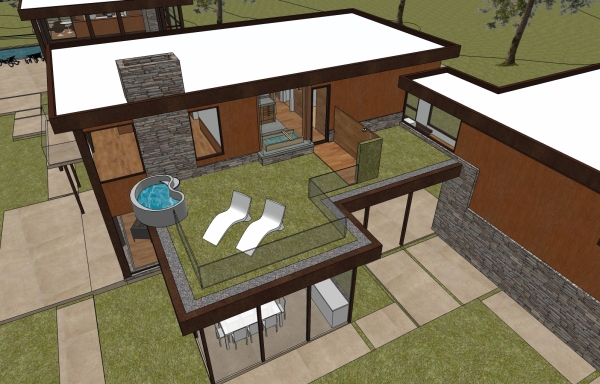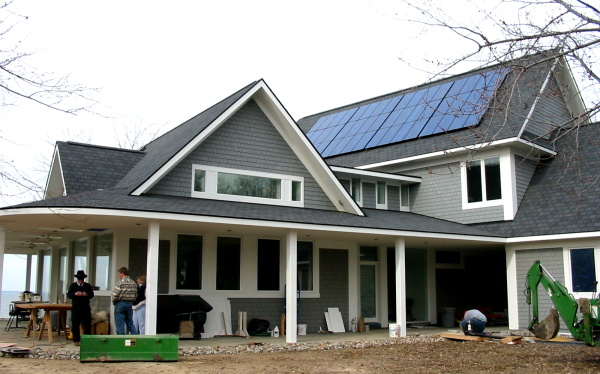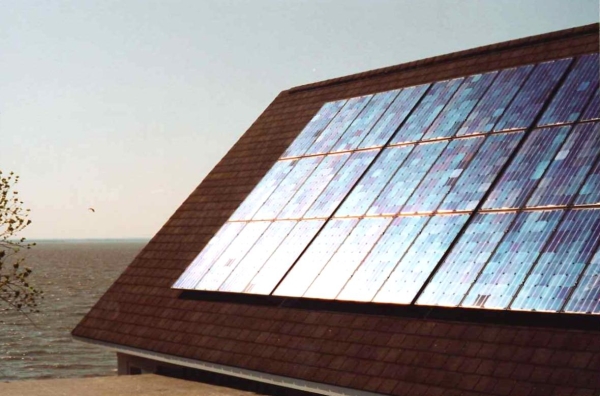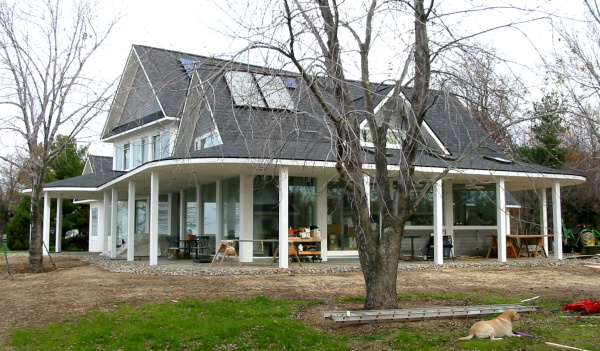|
|

Whitehall Creek Modern

Bay View Home

Modern
Foursquare

Bay View Home

Bay View Home
|
|
Sustainable
Design
Many
of our clients feel that Sustainable Design is a priority. We have a
LEED certified design professional on staff and have successfully
integrated sustainable design features into many of our residential
projects.
Solar Photovoltaic Panels
Solar Photovoltaic Panels supplement electrical power received from the local power authority. At times when the electricity generated from the panels exceeds the home's power consumption, the excess power is transferred back into the grid and the electric meter runs backward. Many states (including Maryland) require power companies to purchase excess power back from their residential customers at the same market rate they charge for usage.
This type of system can further be augmented by adding a battery to store excess energy generated from the solar panels. This stored energy
can then be used during power outages.
Solar Photovoltaic Panels are improving in quality and becoming more affordable every year. With the rising costs of energy we have seen in recent times, the cost benefit ratio is always improving for these systems.
Solar Domestic Hot Water Systems
Domestic hot water heating is the second-highest energy consumer in a typical household. Using solar energy to heat hot water can reduce this cost by 65% or more in the Northeastern U.S. The system includes 2 to 3 solar collectors, which absorb the sun's energy by warming a heat transfer fluid (propylene glycol). This fluid is then used to preheat incoming cold water before it is brought to full temperature by a conventional heating system.
Passive Solar Design
Passive solar design integrates building components - exterior walls, windows, and building materials - to harness natural energy flows and provide solar heating and cooling. Our designs have incorporated this simple, low-cost method to increase energy efficiency for many years. Passive solar design elements include daylighting strategies to limit the use of electricity, heat control techniques such as exterior sun screens, proper solar orientation, appropriate ventilation and window placement, and passive solar heating strategies.
Geothermal Heat Pumps
Geothermal heat pumps rely primarily on the Earth's natural thermal energy, a renewable resource, to heat or cool a building. Geothermal systems require only a small amount of electricity to concentrate and circulate heating or cooling throughout the home. The Earth's natural heat is collected in winter through a
series of pipes (a loop) installed in a well or below the surface of the ground. Fluid circulating in the loop carries this heat to an electrically driven compressor and heat exchanger, and then the heat is distributed inside the house. In summer the process is reversed, and excess heat is drawn from the home, expelled to the loop, and absorbed by the Earth.
Geothermal systems are compact and quiet. Geothermal systems use less energy because they draw heat from the Earth, a source whose temperature is moderate, instead of the outside air. Geothermal systems can also provide hot water, which can be very economical as the same loop may be used.
Green Roofs
A green roof is one that is partially or completely covered with vegetation planted on top of a waterproofing membrane. A complete system can include plants, soil or growing medium, a root barrier, drainage and irrigation systems, waterproofing membrane, roof insulation, and roof sheathing. A planted roof can be maintenance-free or require weeding and watering, depending on the plant types used. Benefits include reduced heating and cooling loads for the building, reduction of the urban heat island effect, increased roof life span, reduced stormwater run off, and the filtering of pollutants from the air and rainwater.
Super Insulation
Bohl Architects has used non-shrinking spray foam icynene or polyurethane insulation on a number of recent projects. This method of insulation has been approved by local building authorities, and is gaining popularity for many reasons. The foam expands during installation to completely seal roof and wall cavities. This effectively blocks air infiltration and air transported moisture, eliminating the need for attic ventilation. Also, if polyurethane is used, a much higher R-value can be achieved. Polyurethane insulation provides 6.46 R/inch, more than twice the amount of fiberglass batt insulation.
Icynene uses a mixture of carbon dioxide and water to eliminate HCFC-related environmental problems that are typical of spray foam insulation. (HCFCs are hydrochloro-fluorocarbons, which are used as blowing agents in extruded foam insulations. They are damaging to the ozone layer and are also significant greenhouse gases.) Polyurethane is available with a non-ozone-depleting HFC foaming agent, and will soon be available with a water-blown foaming agent which will not require HCFCs.
Icynene has also been shown to perform well in indoor air quality studies, and may be a good choice for healthier indoor environments.
Low VOC Building Materials
Bohl Architects routinely specifies paints, adhesives, solvents, sealants, cleaning agents, caulks, wood products and carpeting with low or no volatile organic compounds. These compounds are off-gassed by many common building materials, and contribute to poor indoor air quality. Elevated levels of VOCs have been linked to eye and respiratory irritation, headaches, and fatigue. We are committed to providing healthier indoor environments for all of our clients.
Small Houses
One of the easiest and most economical things that can be done from an environmental perspective is to build smaller houses. Buildings that sit lightly on the land and minimize the area of site disturbance are respectful of the environment. The trend of building larger homes with many rooms, each suited to one purpose, creates sprawling buildings that are expensive to heat and cool, and maintain. A creative and well thought out design can maximize the use of space in a smaller building. Building smaller is less expensive, allowing for higher quality materials and creating less impact on the environment.
|
|





